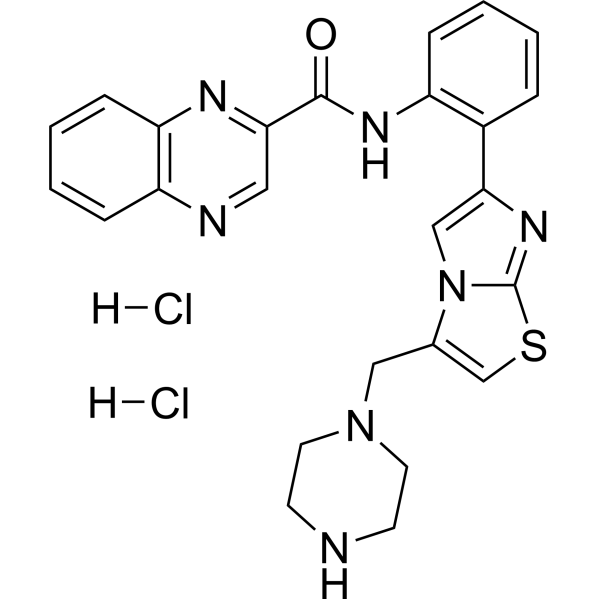SRT 1720 dihydrochloride
Modify Date: 2024-04-02 20:08:01

SRT 1720 dihydrochloride structure
|
Common Name | SRT 1720 dihydrochloride | ||
|---|---|---|---|---|
| CAS Number | 2468639-77-0 | Molecular Weight | 542.48 | |
| Density | N/A | Boiling Point | N/A | |
| Molecular Formula | C25H25Cl2N7OS | Melting Point | N/A | |
| MSDS | N/A | Flash Point | N/A | |
Use of SRT 1720 dihydrochlorideSRT 1720 dihydrochloride is a selective and orally active activator of SIRT1 with an EC50 of 0.10 μM, and shows less potent activities on SIRT2 and SIRT3[1]. |
| Name | SRT 1720 dihydrochloride |
|---|
| Description | SRT 1720 dihydrochloride is a selective and orally active activator of SIRT1 with an EC50 of 0.10 μM, and shows less potent activities on SIRT2 and SIRT3[1]. |
|---|---|
| Related Catalog | |
| Target |
SIRT1:0.10 μM (EC50) |
| In Vitro | 即使在没有 SIRT1 的情况下,SRT 1720 dihydrochloride 也能有效地降低细胞中 p53 的乙酰化,这归因于组蛋白乙酰转移酶 p300[2]。 |
| In Vivo | SRT 1720 (10, 30, 100 mg/kg, p.o.) dihydrochloride 处理显著降低 Lepob/ob 小鼠的空腹血糖至接近正常水平[1]。 SRT 1720 dihydrochloride 能够保护小鼠免受饮食诱导的肥胖的负面影响,并通过 SIRT1 的下游靶点,如 PGC1α 和 FOXO1,与脂肪酸和氧化代谢的代谢适应有关[2]。 SRT 1720 (50-100 mg/kg, p.o.) dihydrochloride 在肺气肿发展过程中减弱弹性酶诱导的气道扩大和肺功能损害,并降低野生小鼠的动脉氧饱和度[3]。 |
| Animal Admin | Mice: Nine week old C57BL/6 male mice are fed a high fat diet (60% calories from fat) until their mean body weight reach approximately 40 g. The mice are then divided into test groups (6-10 per group). SRT1460 (100 mg/kg), SRT 1720 (100 mg/kg), SRT501 (500 mg/kg) and BRL49653 (5 mg/kg) are administered once daily via oral gavage. The vehicle used is 2% HPMC + 0.2% DOSS. Individual mouse body weights are measured twice weekly. At 2, 4, 6, 8 and 10 weeks of dosing a fed blood glucose measure is taken and after 5 weeks of treatment an IPGTT is conducted on all mice from each of the groups. After 10 weeks of treatment, an ITT is conducted. Statistical analysis is completed using the JMP program. Data are analyzed by a one way ANOVA with comparison to control using a Dunnett’s Test. A p value < 0.05 indicates a significant difference between groups. |
| References |
| Molecular Formula | C25H25Cl2N7OS |
|---|---|
| Molecular Weight | 542.48 |